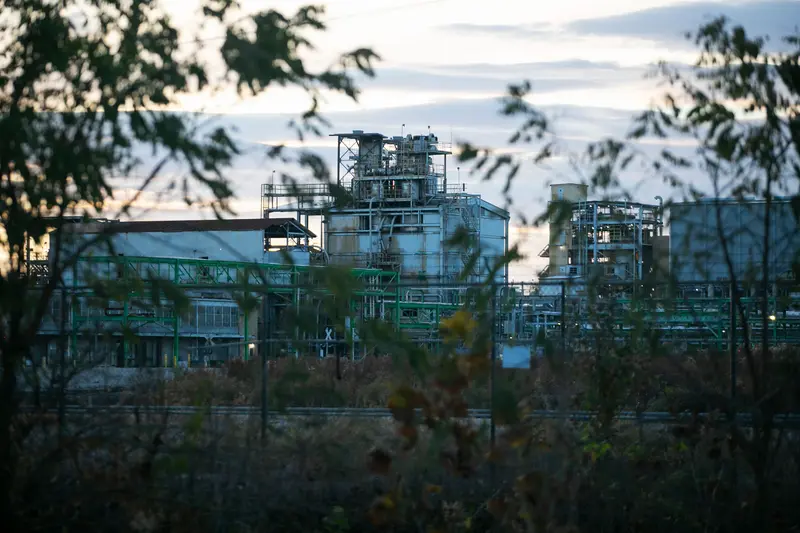ProPublica is a nonprofit newsroom that investigates abuses of power. Sign up to receive our biggest stories as soon as they’re published. This article was produced by Mountain State Spotlight, a member of ProPublica’s Local Reporting Network.
A citizens’ group in West Virginia is suing the Environmental Protection Agency, alleging that federal regulators have failed to protect a majority-Black community in the state and residents of parts of Louisiana and Texas from cancer-causing chemicals.
A 2021 Mountain State Spotlight and ProPublica story detailed how largely Black communities across the country, like Institute in West Virginia, were saddled with a disproportionate health burden from industrial pollution. ProPublica’s analysis of emissions data found that on average, the level of cancer risk from industrial air pollution in majority-Black census tracts was more than double that for majority-white areas.
Earlier this year, the EPA proposed tougher air pollution rules for chemical plants and other industrial facilities, including placing stricter limits on ethylene oxide — the same chemical released by the plant in Institute. But the proposed rules wouldn’t cover the main ethylene oxide polluters in West Virginia because those plants fall under a different industry category in EPA regulation.
Pam Nixon, a former Institute resident and member of the Charleston, West Virginia-based People Concerned About Chemical Safety, which filed the lawsuit, said her community was often neglected by the EPA.
“There is no justice yet until all communities are treated the same and until people everywhere are breathing clean air and it doesn’t impact the health of their families,” said Nixon. While it can be difficult to link specific cases of disease to pollution exposure, she said she suffered from blisters and autoimmune problems after being exposed to a leak from the Institute plant in 1985.
The lawsuit filed Monday notes that the EPA missed a legally required deadline to update federal emissions standards for facilities that produce polyether polyols, a type of chemical that leads to the emission of carcinogens including ethylene oxide.
These facilities are major sources of pollution that disproportionately affect communities of color and lower-income areas, which are often already burdened by industrial development.
Institute, which is in one of West Virginia’s only two majority-Black census tracts, faces an excess cancer risk from industrial air pollution that is 36 times the level the EPA considers acceptable from the nearby Union Carbide plant — a facility that has helped define West Virginia’s “Chemical Valley.”
That Union Carbide facility makes ethylene oxide, which is used in various products, including antifreeze, pesticides and sterilizing agents for medical tools.
A 2021 ProPublica analysis found that of over 7,600 facilities across the country that increase the estimated cancer risk in nearby communities, the Institute plant ranked 17th.
Dow Chemical, which owns Union Carbide, did not respond to an emailed request for comment, or to multiple requests sent during research for the 2021 story.
Elevated cancer risks also affect an area known as “Cancer Alley” along the Mississippi River between Baton Rouge, Louisiana, and New Orleans, as well as around Houston, Texas. Both of those regions also have clusters of polyether polyol production facilities, according to the lawsuit.
The Louisiana Environmental Action Network and the Sierra Club joined the West Virginia organization in its lawsuit against the EPA. Environmental groups commonly pursue legal action when the agency misses deadlines.
The EPA is required by the Clean Air Act to review and update emission standards for hazardous air pollutants every eight years, but the agency hasn’t made any substantive revisions to the emission standards for this source category since 1999, according to Adam Kron, an attorney for Earthjustice representing the environmental groups.
In 2014, the EPA made minor changes to how polyether polyol is monitored and measured but decided not to make any revisions to emissions rates after a review that looked at whether the current standards adequately protect communities against health risks.
In the lawsuit, the environmental groups argue that the EPA has failed to perform its required duties by missing its 2022 deadline.
Because regulators missed the deadline, the lawsuit is asking the court to find the EPA in violation of the Clean Air Act and to compel the agency to update the emissions standards by a swift deadline set by the court itself.
The EPA declined to comment because of the pending litigation.
The groups argue in the lawsuit that in addition to missing deadlines, EPA’s regulation has failed to keep up with science. In 2016 — two years after the EPA reviewed the standards — the agency determined that ethylene oxide’s cancer risk was nearly 60 times greater than previously thought.
But even after that finding, the agency didn’t update its standards. In 2021, the EPA’s Office of the Inspector General urged the agency to review polyether polyol production before its 2022 deadline after a report on ethylene oxide-emitting source categories found that the EPA was failing to meet required deadlines for conducting reviews.
The inspector general’s report also noted that the EPA couldn’t guarantee that the current emissions standards were adequately protecting public health because it had fallen behind on reviewing them, according to the lawsuit.
In response to the report, EPA regulators said they planned to complete a review of emissions standards for facilities like the one in Institute by late 2024 — more than two years after the deadline.


















